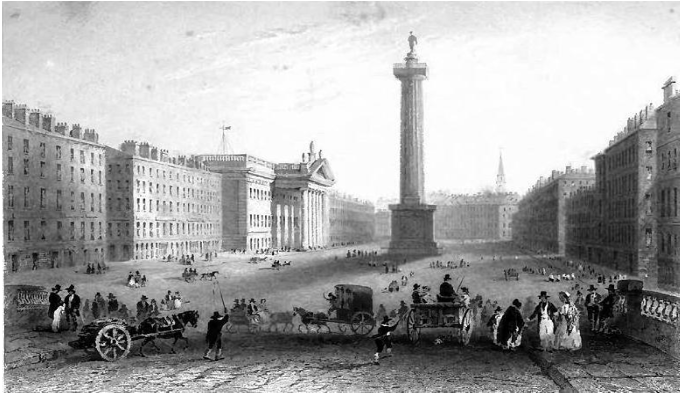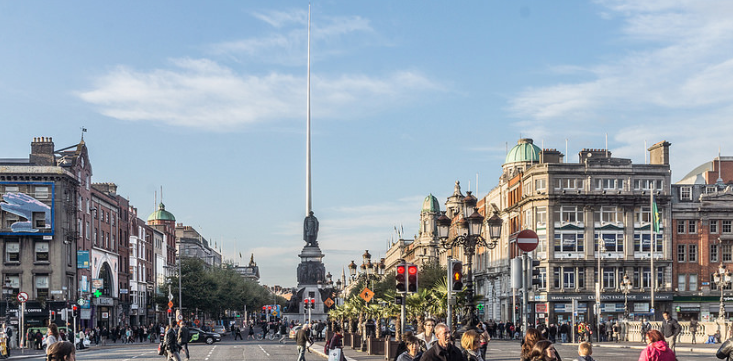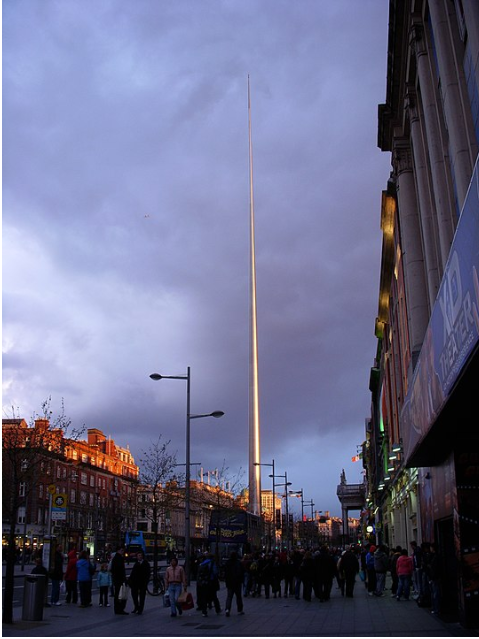The Spire of Dublin is a striking symbolic structure located in the heart of Dublin, opened in 2002 and standing 120 meters tall.
At 120 meters high and with a base diameter of 3 meters, the Spire rises over O'Connell Street. During daylight, the street views and people are reflected on the Spire's stainless steel surface. Thus, it has a highly reflective surface up to about 10 meters from the base, with slightly less reflectivity above that height.
The tip of the Spire has a diameter of about 15 centimeters. When the wind blows, the top of the Spire sways slightly, reflecting the character of the city’s climate. The tip can sway up to a maximum of 1.5 meters under extreme wind load; if you're nearby when this happens, don’t panic—tall, slender structures, even lamp posts, can sway in the wind!
Historical Story of the Spire of Dublin
The Nelson Pillar

The bombing of the Nelson Pillar in 1966, as depicted by William Henry Bartlett in the 1840s, left a significant gap on O'Connell Street in the heart of Dublin city center. However, despite the destruction, the void left by the bombing was only filled 37 years later, on January 22, 2003.
The foundation stone of the Nelson Pillar was laid by the Duke of Redmond, Lord Lieutenant, on February 22, 1808, and its construction cost £6,856. The pillar was designed by Irish sculptor Thomas Kirk and was reduced to rubble by a powerful explosion in March 1966.
Following the explosion, it was clear that the pillar needed to be replaced, and initial proposals in the 1970s called for a monument to be erected in honor of Irish revolutionary and Easter Rising leader Padraig Pearse, coinciding with his 100th birthday.
The proposed monument was to cost £150,000 and would have been taller than the neighboring GPO, where Pearse fought in 1916, but this plan fell through.
Later, in 1988, the year of Dublin's millennium, renovation proposals gained momentum, leading to the establishment of “The Pillar Project.”

The Pillar Project
The Pillar Project aimed to bring together artists and architects to design a monument that could replace the Nelson Pillar. Among the ambitious proposals was a “Millennium Arch,” featuring an infinite flame at the top, symbolizing the city's distinctive spirit and resembling the iconic Arc de Triomphe in Paris.
Other proposals in the early 1990s included restructuring the pillar to feature James Joyce as a non-political, non-military, and non-divisive figure at the top.
However, like the plans a decade prior, the Pillar Project and other proposals also came to nothing.
In 1998, an international competition was launched, inviting potential competitors with the following statement:
“The monument will have a vertical emphasis and elegant structure, related to the quality and scale of O’Connell Street as represented in recent times, and suitable for contemporary design in the 21st century.”
A total of 205 participants responded to the call for O'Connell Street, and after elimination, the designs were narrowed down to three: two firms based in England and one based in Dublin.
The winner of the competition was Ian Ritchie Architects, a London-based firm, who designed the current Dublin Spire.
The Spire was built in six different sections and was initially expected to be completed by the year 2000. Due to the difficulties in obtaining planning permission and a High Court case, the first section was only built on December 18, 2002, with the Dublin Spire completed in January 2003.
Thousands gathered on a cold January day on O'Connell Street to witness the installation of the final section of the Spire, which has since become a symbol of this historic city.
The Spire

With a total cost reaching €4 million, the Dublin Spire stands at an incredible height of 120 meters (400 feet) and has a base width of 3 meters. The Spire serves as the tallest structure in Dublin city center.
The top of the Spire is 15 centimeters wide and is illuminated with LED lights. It is also alternatively known as An Túr Solais (Light Monument).
Contrary to initial beliefs, the tower does not clean itself and needs to be cleaned every eighteen months. The cost of the first cleaning was around €120,000.
The tower's charm is etched into its design. In daylight, the life of the city can be seen reflected in the Spire's stainless steel surface, with the twilight of evening casting shadows on the steel as day turns to night.
The fixed buildings on either side of the Spire can also be seen during the day, while its illuminated structure lights up the city at night.
The Significance of the Spire
Pointing skyward like a needle, the Dublin Spire is a symbolic structure that truly pierces the hearts and minds of the city’s inhabitants, and it is the first thing you notice as you make your way toward Dublin city center.
The beauty of the Spire lies in its sole tribute to Dublin's vibrant present, while also pointing toward an unlimited, brighter future.






